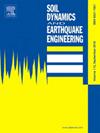Soil-structure interaction effects on the semi-active control effectiveness of structures using MR damper: Shaking table investigation
IF 4.2
2区 工程技术
Q1 ENGINEERING, GEOLOGICAL
引用次数: 0
Abstract
To investigate the soil-structure interaction (SSI) effects on the semi-active control effectiveness, shaking table tests were carried out on a two-story steel frame structure with magnetorheological (MR) damper located on a fixed-base and soft soil foundation. First, a novel online learning deep neural network fuzzy control method (OL-DFNN) was used to control the structure equipped with MR dampers. The controller was made up of three modules, namely the offline trained deep neural network fuzzy control (DFNN), the online training module and the control structure system with SSI effects. Second, other control methods (passive ON, ON-OFF, and DFNN) were also examined to investigate the control efficiency when considering the SSI. Three different earthquake excitations were selected as the seismic inputs, recorded from El Centro, Kobe, and Tianjin earthquakes. Finally, shaking table tests of the structures with and without considering the SSI effect were carried out. The displacement and acceleration test results were comparatively evaluated using two performance indices: peak and root mean square (RMS) responses. The test results indicated that OL-DFNN control achieved the best control efficiency among the four control strategies for both fixed-base structures and soft soil foundation structures. Compared to fixed-base structures, the semi-active control effectiveness of the structures where the SSI effect is taken into account was reduced.
求助全文
约1分钟内获得全文
求助全文
来源期刊

Soil Dynamics and Earthquake Engineering
工程技术-地球科学综合
CiteScore
7.50
自引率
15.00%
发文量
446
审稿时长
8 months
期刊介绍:
The journal aims to encourage and enhance the role of mechanics and other disciplines as they relate to earthquake engineering by providing opportunities for the publication of the work of applied mathematicians, engineers and other applied scientists involved in solving problems closely related to the field of earthquake engineering and geotechnical earthquake engineering.
Emphasis is placed on new concepts and techniques, but case histories will also be published if they enhance the presentation and understanding of new technical concepts.
 求助内容:
求助内容: 应助结果提醒方式:
应助结果提醒方式:


